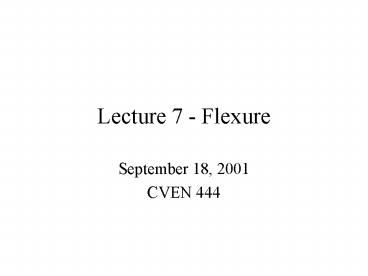Lecture 7 Flexure - PowerPoint PPT Presentation
1 / 30
Title:
Lecture 7 Flexure
Description:
Plane sections remain plane ( not true for deep beams h 4b) ... GR 60 or Welded Wire Fabric (WWF): As (T&S) = 0.0018 Ag. Ag - Gross area of the concrete ... – PowerPoint PPT presentation
Number of Views:125
Avg rating:3.0/5.0
Title: Lecture 7 Flexure
1
Lecture 7 - Flexure
- September 18, 2001
- CVEN 444
2
Lecture Goals
- Basic Concepts
- Rectangular Beams
- Non-uniform beams
- Balanced Beams
3
Flexural Stress
Basic Assumptions in Flexure Theory
- Plane sections remain plane ( not true for deep
beams h gt 4b) - The strain in the reinforcement is equal to the
strain in the concrete at the same level, i.e. es
ec at same level. - Stress in concrete reinforcement may be
calculated from the strains using s-e curves for
concrete steel.
4
Flexural Stress
Additional Assumptions for design (for
simplification)
- Tensile strength of concrete is neglected for
calculation of flexural strength. - Concrete is assumed to fail in compression, when
ec (concrete strain) ecu (limit state) 0.003 - Compressive s-e relationship for concrete may be
assumed to be any shape that results in an
acceptable prediction of strength.
5
Flexural Stress
The concrete may exceed the ec at the outside
edge of the compressive zone.
6
Flexural Stress
The compressive force is modeled as Cc k1k3fc
bc at the location x k2c
7
Flexural Stress
The compressive coefficients of the stress block
at given for the following shapes. k3 is ratio
of maximum stress at fc in the compressive zone
of a beam to the cylinder strength, fc (0.85 is
a typical value for common concrete)
8
Flexural Stress
The compressive zone is modeled with a equivalent
stress block.
9
Flexural Stress
The equivalent rectangular concrete stress
distribution has what is known as a b1
coefficient is proportion of average stress
distribution covers.
10
Flexural Stress
Requirements for analysis of reinforced concrete
beams
1 Stress-strain Compatibility -Stress at a
point in member must correspond to strain at a
point 2 Equilibrium Internal forces balance
external forces
11
Flexural Stress
Example of rectangular reinforced concrete beam.
(1) Setup equilibrium.
12
Flexural Stress
Example of rectangular reinforced concrete beam.
(2) Find flexural capacity.
13
Flexural Stress
Example of rectangular reinforced concrete beam.
(3) Need to confirm esgtey
14
Flexural Stress
Example of rectangular reinforced concrete beam.
Given a rectangular beam fc 4000 psi b1
0.85 fy 60 ksi (4 7 bars) b 12 in. d
15.5 in. h 18 in. Find the neutral axis. Find
the moment capacity of the beam.
15
Flexural Stress - Example
For a non-rectangular beam
Given that the beam with concrete rated at fc
6000 psi and the steel is rated at fs 60,000
psi. d 12.5 in. (a) Determine the area of the
steel for a balanced system. (b) Determine the
moment capacity of the beam. Mn (c) Determine
the NA.
16
Three possibilities in Inelastic Behavior
- Compression Failure - (over-reinforced beam)
- Tension Failure - (under-reinforced beam)
- Balanced Failure - (balanced reinforcement)
17
Inelastic Behavior
Compression Failure
The concrete will crush before the steel yields.
This is a sudden failure. The beam is known as an
over-reinforced beam.
18
Inelastic Behavior
Tension Failure
The reinforcement yields before the concrete
crushes. The concrete crushes is a secondary
compression failure. The beam is known as an
under-reinforced beam.
19
Inelastic Behavior
Balanced Failure
The concrete crushes and the steel yields
simultaneously. The beam is known as an
balanced-reinforced beam.
20
Inelastic Behavior
Which type of failure is the most desirable?
The under-reinforced beam is the most
desirable. fs fy es gtgt ey You want ductility
system deflects and still carries load.
21
Limitations on Reinforcement Ratio, r
For rectangular cross-sections, r 1 Upper
Limit on r
ACI 10.3.3 This will ensure steel
yields es (1.8 to 2.0)ey _at_ failure
22
Limitations on Reinforcement Ratio, r
It is best to keep r ( 0.4 to 0.5 )rbal to
allow enough space to place reinforcement and to
limit cracking and deflection. 2 Lower Limit on
r ACI 10.5.1
ACI Eqn. 10 - 3 fc
fy are in psi
23
Limitations on Reinforcement Ratio, r
2 Lower Limit on r ACI 10.5.1 Lower
limit used to avoid Piano Wire beams. Very
small As ( Mn lt Mcr ) es is huge (large
deflections) when beam cracks (Mn gt Mcr ) beam
fails right away because Mn lt Mcr
24
Additional Requirements for Lower Limit on r
If As (provided) 4/3 As (required) based on
analysis, then As (min) is not required.
for
As (provided) See ACI 10.5.3
25
Additional Requirements for Lower Limit on r
Temperature and Shrinkage reinforcement in
structural slabs and footings (ACI 7.12) place
perpendicular to direction of flexural
reinforcement. GR 40 or GR 50 Bars As (TS)
0.0020 Ag GR 60 or Welded Wire Fabric (WWF)
As (TS) 0.0018 Ag Ag - Gross area of the
concrete
26
Determine Balanced Reinforcement Ratio, rbal
rbal unique r value to get simultaneous ec
0.003 es ey
Use similar triangles
27
Determine Balanced Reinforcement Ratio, rbal
The equation can be rewritten to find cb
28
Determine Balanced Reinforcement Ratio, rbal
The equation can be rewritten to find rbal
29
Example - Balanced Reinforcement Ratio, rbal
Given b 12 in. d 15.5 in. h 18 in. fc
4000 psi fy 60 ksi (4 7 bar) Determine As(bal),
As(allow) As(min)
30
Example
Given fc 3 ksi fy 40 ksi Determine (1)
the balanced steel reinforcement. (2) the maximum
reinforcement area allowed (3) position of the NA
and depth of the compressive stress block.































